The Harry Potter series by J.K. Rowling has become a cultural phenomenon. Since the release of the first book, Harry Potter and the Philosopher’s Stone (or, for some, the Sorcerer’s Stone), the world has been enthralled, and the rest is history.
The series’ broad fictional world-building is one of its most remarkable features. Rowling built a fantastic universe and expanded on it with each new novel, adding more and more inventive features.
People have certain preconceived notions about this plot, which is loaded with major fantasy elements, such as superpowers and supernatural beings. Rowling takes this into account and employs supernatural creatures as a focal point in her stories, not just as a way to spice up an already great universe.
Some of these animals, such as dragons and phoenixes, were already known in fantasy lore. Rowling, on the other hand, developed several new ones in Harry Potter, such as thestrals and hippogriffs, and individualized them as well. As a result, they are more than just mythical creatures; they are also a character in the story.
So, without further ado, let us dive right into this video, where we geek out about eleven such otherworldly creatures from the franchise!
Dementors
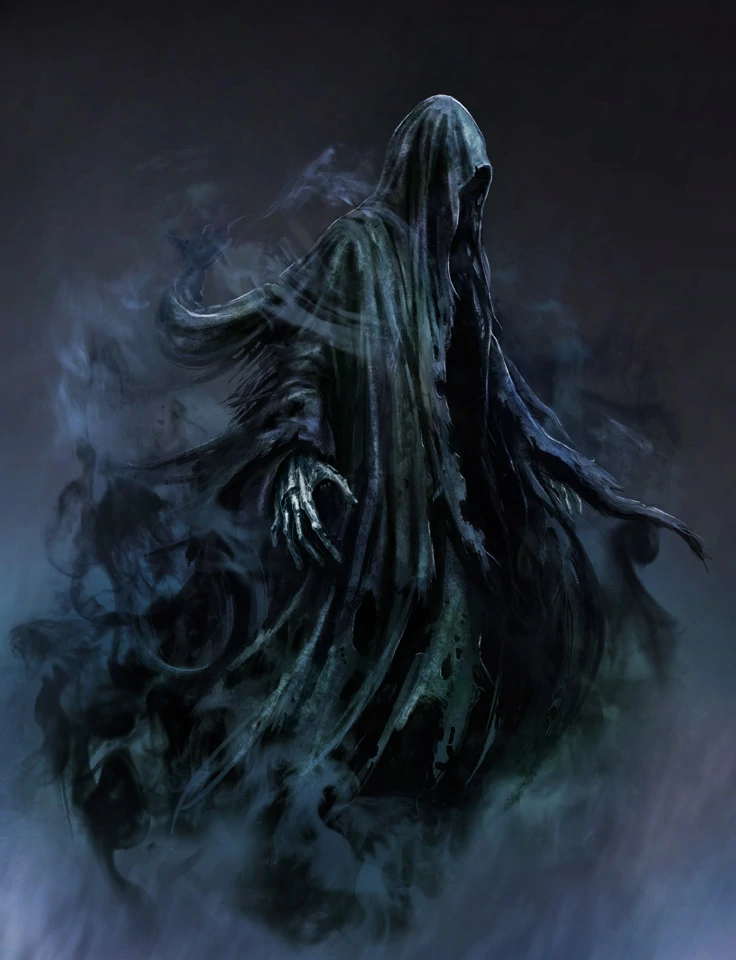
Dementors are dark creatures that look like Death quite literally, it’s almost like it’s the Harry Potter equivalent of The Grim Reaper. It is easily considered one of the most dangerous creatures in the Potterverse and its wizarding world.
Conceptually, it is pretty dark. Dementors feed on positive human feelings such as happiness, and while it sucks that away, its prey undergoes severe depression and despair, replaying some of their worst memories in their head.
In worst-case scenarios, dementors can consume a person’s soul, not killing the victim but permanently leaving them in a vegetative state.
They are almost three meters high, and they glide while transporting themselves. They wear long black clothes that make them resemble Death. Whatever body it has, if it has any, looks decayed like a corpse, and if there are dementors near you, their presence is indicated by a sudden drop in the temperature.
Where there should be a mouth, there was a large hole. The dementors would use this to separate the soul from its victim and inflict them with depression and despair. This infamous act is known as the Dementor’s Kiss. Pretty dark for what is supposed to be a children’s series.
They did not have eyes, though, but that did not stop them from being terrifying as they would just sense their prey by sensing their emotions.
Dementors were basically used as prison guards in the infamous prison of Britain’s Wizarding Society – Azkaban. And they did a pretty great job keeping the convicts from escaping or rioting because how can anyone bring themselves to do anything when they are constantly re-living their worst memories. These are ‘soul-sucking’ fiends who turn people into empty shells after giving them the notorious kiss. However, their effectiveness as the prison guards meant that they were tied to the Ministry of Magic.
Following Voldemort’s defeat after the Second Wizarding War, Kingsley Shacklebolt i.e. the new Minister for Magic, reformed the system and stopped using Dementors in Azkaban. This was mainly due to them switching their allegiance to serve Voldemort following his return in Harry Potter and the Goblet of Fire.
Wizards could defend themselves against these foul creatures by using the Patronus Charm.
They first appeared in Harry Potter and the Prisoner of Azkaban to guard Hogwarts since Sirius Black (who was allegedly a mass murderer at the time) was at loose.
Harry encountered a ‘Dementor’ again in Harry Potter and the Goblet of Fire during the Triwizard Tournament but realized that it was not a dementor but a boggart. Later that day, Cornelius Fudge brought along a Dementor after discovering the escape of Bartemius Crouch Junior, much to the displeasure of Minerva McGonagall.
They returned in Harry Potter and the Order of the Pheonix during the very first chapters/scenes as Harry and Dudley encountered a Dementor in Privet Drive, which kick-started the plot as Harry had to use underage magic to ward off the Dementor with the help of his Patronus.
They joined the Battle of Hogwarts towards the end on the side of Lord Voldemort.
Basilisk
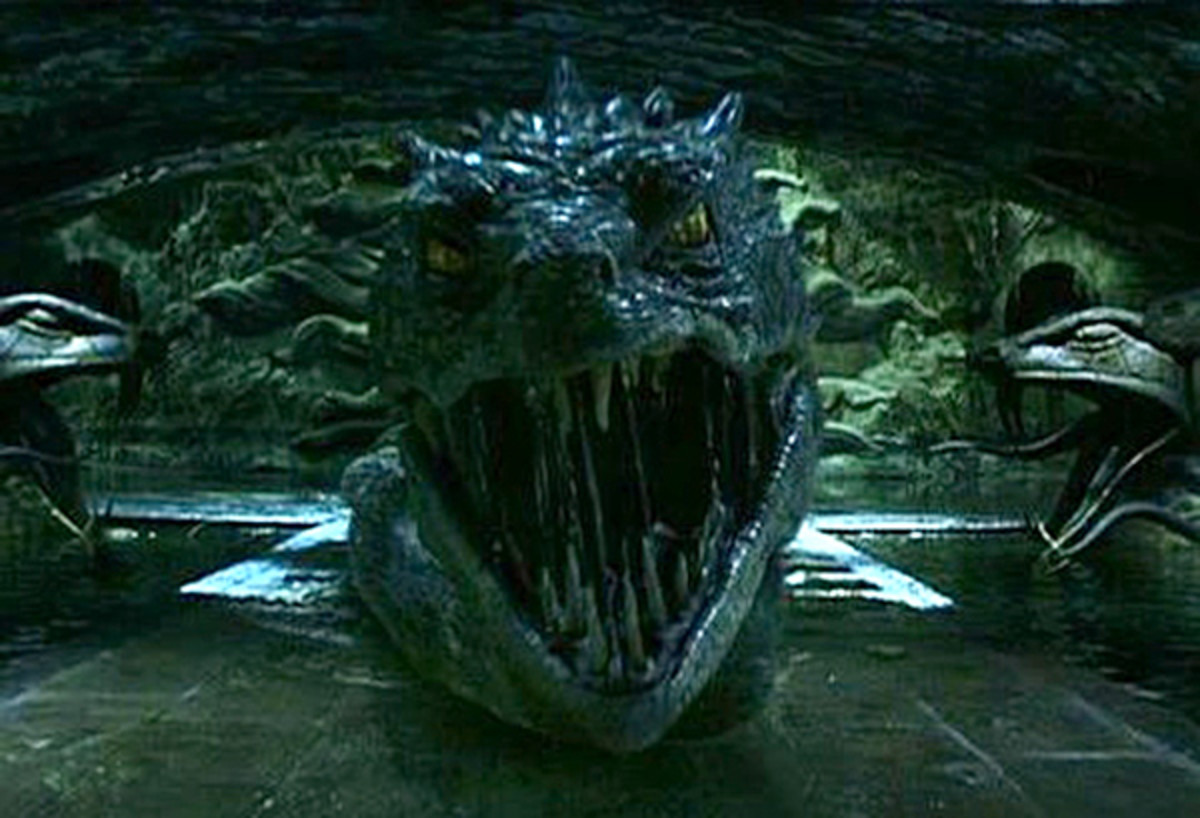
If you know Harry Potter, you know that it has some evil serpents. Most of the evil things in the Potterverse are connected with snakes, such as Voldemort’s entire aesthetic, House Slytherin, and the mark of the Death Eaters. So it is only natural for it to have an evil serpentine creature, which brings us to the Basilisk.
Also known as the King of Serpents, this giant snake was bred by Dark Wizards and, in this case, Salazar Slytherin. It was classified as one of the most dangerous creatures in the Wizarding world and could not be domesticated.
However, those who spoke Parseltongue (aka the language of the snakes) could communicate with it, something we see Tom Riddle do in Chamber of Secrets. But, Harry, who could also speak with snakes due to being Voldemort’s Horcrux, could not influence it.
These giant serpents grew up to fifty feet in length and were dark green in color. That combined with ominous yellow eyes made them an evil force to be reckoned with. Their skin was similar to a dragon with its rugged, impenetrable shell and could cast off any spell. They lived for nine hundred years, but Salazar Slytherin’s Basilisk was said to have lived for over a thousand since it was put in a deep sleep via the usage of Parseltongue.
It had a range of terrifying abilities. Looking at it guaranteed instant death. However, if you looked at its reflection instead, you would get petrified. This is precisely what had happened with the students of Hogwarts, including Hermione in Chamber of Secrets, as she had seen the Basilisk through a reflection on a mirror.
When Myrtle Warren was alive, she had seen the Basilisk directly, and that’s how she died. The only way to de-petrify someone who has indirectly looked at a Basilisk’s eyes would be by giving them the Mandrake Restorative Draught. If a Basilisk were rendered blind, it would lose its power.
Another terrifying ability of the Basilisk is its ridiculous venom which could kill anyone within minutes. Before dying, the person would become drowsy while their vision got blurry (something that we see happening with Harry after being attacked by the venom in the climactic scene of Chamber of Secrets). The only cure for this was Phoenix’s tears. Harry could only survive his encounter with the Basilisk because Dumbledore’s phoenix, Fawkes, used its tears on Harry.
The fang of a Basilisk had immense destructive potential and could damage anything beyond the point of being restored, making it an effective Horcrux-destroyer.
Spiders had an extreme aversion to the Basilisk, as was seen of Aragog who could not even take its name out of fear. Salazar Slytherin had initially bred it by hatching a chicken egg beneath a toad to purge Hogwarts of Muggleborn witches and wizards. It wasn’t until Tom Riddle’s time in Hogwarts that the Chamber of Secrets (the place where the Basilisk rested) was opened.
It was reopened once again during the present-day events of Harry Potter and the Chamber of Secrets, which is where it made its first appearance. It appeared again in Deathly Hallows but only as a corpse because Harry had already slain it using the Sword of Godric Gryffindor.
Hungarian Horntail
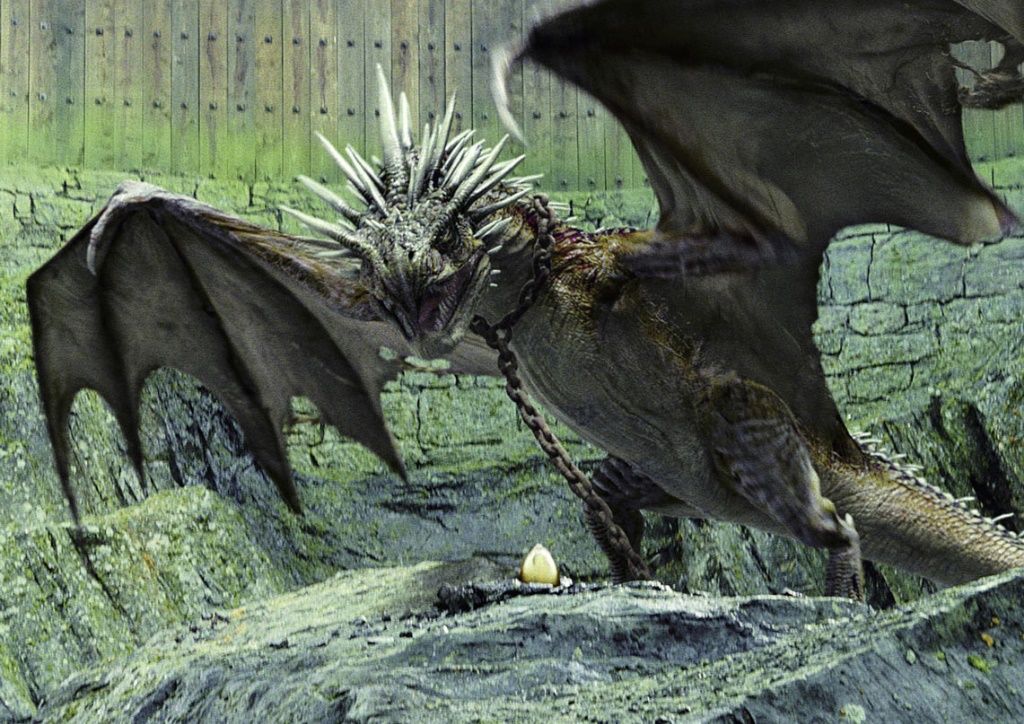
What’s a fantasy series without some dragons? The Potterverse has some iconic dragons in it, and no, they’re not just any dragons. They all have unique names, appearances, and features. In Harry Potter and the Goblet of Fire, Harry encountered the Hungarian Horntail during his first task in the Triwizard Tournament.
As you can judge from its name, the Hungarian Horntail is a species native to Hungary and considered one of the most dangerous dragon breeds. It only makes sense that the main character will have to steal an egg from the most hazardous dragon compared to others.
It made its first appearance in the Potterverse in Goblet of Fire during the 1994 Triwizard Tournament, alongside other dragons such as the Chinese Fireball, Common Welsh Green, and Swedish Short-Snout, as the first obstacle during the Golden Egg retrieval task.
Except this lizard was jacked on some supernatural steroids. It had impenetrable black scales and looked similar and, being a reptile, had a lizard-like appearance. Its eyes were yellow and had vertical, reptilian pupils. It also had bronze horns while its tail had bronze spikes protruding from it, giving it the name ‘Horntail.’ Of course, this tail was one of its trump cards in combats.
It had a screeching scream. Its flames would reach far and wide, often over fifty feet, while its breath recorded high temperatures. Even though the Horntail feasted on cattle, goats, and sheep, it was not averse to some good old human meat.
Despite all the dragons in the Potterverse being aggressive and ferocious, the Horntail had a reputation for going overboard with its aggressiveness over the other dragons. When Rubeus Hagrid, the man who cries for giant spiders, calls something a ‘nasty piece of work,’ it is the real deal. Its ferociousness got amped up when protecting its younger ones, and unfortunately, Harry had to bear the ‘heat’ of that (pun intended) when he had to snatch the Horntail’s egg from its lair in the First Task.
In combat, not only is the Hungarian Horntail ridiculously strong, but it is also really fast. It was easily able to keep up with Harry, who was flying on a Firebolt broomstick which went at a speed of 150 miles per hour. This feat, combined with the Horntail’s size and firepower, is no joke.
A certain Miss Targaeryan would’ve had her eyes on this one in particular during a crossover episode.
Merpeople
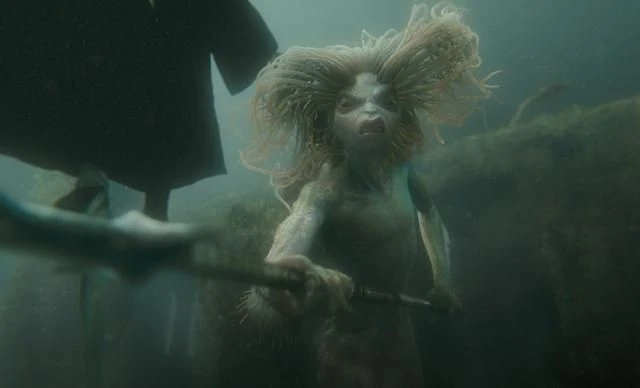
Expanding on the culture of mermaids, J.K. Rowling introduced a community of sentient magical beasts – the Merpeople. As you can already expect, they lived underwater. Since the Wizarding World is an expansive one and is not limited to the United Kingdom, Merpeople could be found worldwide.
They were similar to centaurs in the way that they were half ‘human’ and half-fish, even though whether their top half is ‘human’ or not is an arguable concept in itself. Technically, they are not hybrids and are a separate species instead.
For example, the Merpeople seen in the Harry Potter books and movies had green hair with yellow eyes and grey skin and their silver tail. So even though their bottom half can resemble a huge fish, their top half is far from human-like. Their lifestyles, habits, and customs were mysterious, and they were offered the status of ‘being,’ similar to the centaurs, but they refused as they did not want to be categorized with vampires and hags. This is why they were not represented in the Fountain of Magical Brethren.
They probably had gills considering they lived underwater mainly, but they could breathe above the water for short periods. However, it is not known whether they can ever truly leave their habitats.
This colony of Merpeople living in the Black Lake on the grounds of Hogwarts was called Selkies. They are Scottish Merpeople and are significantly less beautiful than the Merpeople colonies living in warmer waters. For example, the Merrows of Ireland were known to be better looking. They were also taller than humans and would often be seven feet, but this height is pretty common for selkies.
The selkie Harry had encountered in the lake was seven feet and had a long green beard. This happened during the Second Task of the Triwizard Tournament in Harry Potter and the Goblet of Fire. Their task was to put four people in an enchanted sleep for an hour until one of the four Champions arrived to save them. When Harry tried to save more than one person, the Merpeople tried to stop him with spears.
However, the relationship between Wizardkind and Merpeople is not amicable and is often quite unstable. For example, Dolores Umbridge has expressed her distaste towards anything non-human time and again. During her time in the Ministry, she wanted them to be rounded up and tagged, but fortunately, nothing of this was put into effect.
Many from the Wizarding society often looked down upon the Merpeople as inferior creatures, making the relationship between the two even sourer. As we already know, the supremacists in the magical community had a superiority complex over those without magical prowess – sentient beings and, of course, Muggles. So, this could be one reason why the relationship between the two is seemingly unstable.
However, they did cooperate with the Wizarding World during the Triwizard Tournament. The Selkies from the Black Lake were also present in Dumbledore’s funeral in Half-Blood Prince as they respected him. This could be due to Dumbledore himself being more open-minded and accepting, which put him in the good books of the Merpeople, earning their respect.
Hippogriff
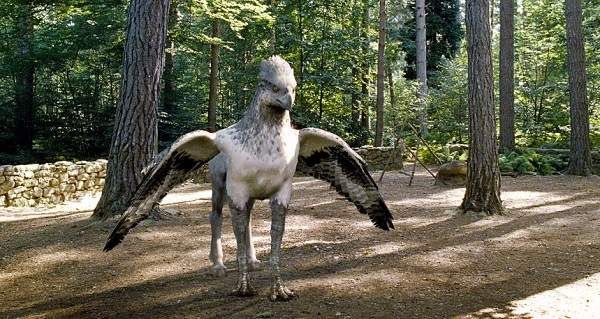
Making its debut in Harry Potter and the Prisoner of Azkaban during a Care of Magical Creatures Class by Rubeus Hagrid, hippogriffs soon became a fan-favorite.
They are magical beasts who had the wings, front legs, and head of a giant eagle, while their lower half resembled that of a horse. It wouldn’t be a stretch to say that Rowling was inspired by Griffins while creating the hippogriff and chose to go with a horse rear over Griffin’s lion.
Their beaks were large and steel-colored while their eyes were orange. They also had talons on their front legs which were almost a foot long and pretty deadly.
Being carnivorous, these creatures were extremely dangerous but trained witches and wizards could train them. As seen in Prisoner of Azkaban, Hagrid asks his students to approach the hippogriff with proper etiquette because otherwise, it can be quite dangerous (you don’t want to be in Draco Malfoy’s position for this one). These creatures were proud so it only makes sense to treat them with respect and bow to them, while maintaining eye contact. If they like you they will bow back.
After provoking Draco Malfoy, the hippogriff Buckbeak was sentenced to death. However, Harry and Hermione went back in time to save him, following which he came under the care of Sirius Black. After Sirius died, he passed on Buckbeak on to Harry. Buckbeak went on to show strong loyalty towards Harry. However, they were also fiercely loyal to those who earned their trust.
For example, in Half-Blood Prince, the hippogriff Buckbeak attacked Severus Snape to protect Harry during the Battle of the Astronomy Tower. Once again, it led the thestrals of Hogwarts into battle against Voldemort’s giants in Deathly Hallows during the Battle of Hogwarts.
It was illegal to use hippogriffs for personal transportation due to laws set by the International Statute of Wizarding Secrecy. Those who owned a hippogriff were required to cast a Disillusionment Charm on them to prevent it from being spotted by Muggles.
In the Potterverse, a herd of Hippogriffs was owned by Hogwarts itself and cared for by Rubeus Hagrid.
Trolls
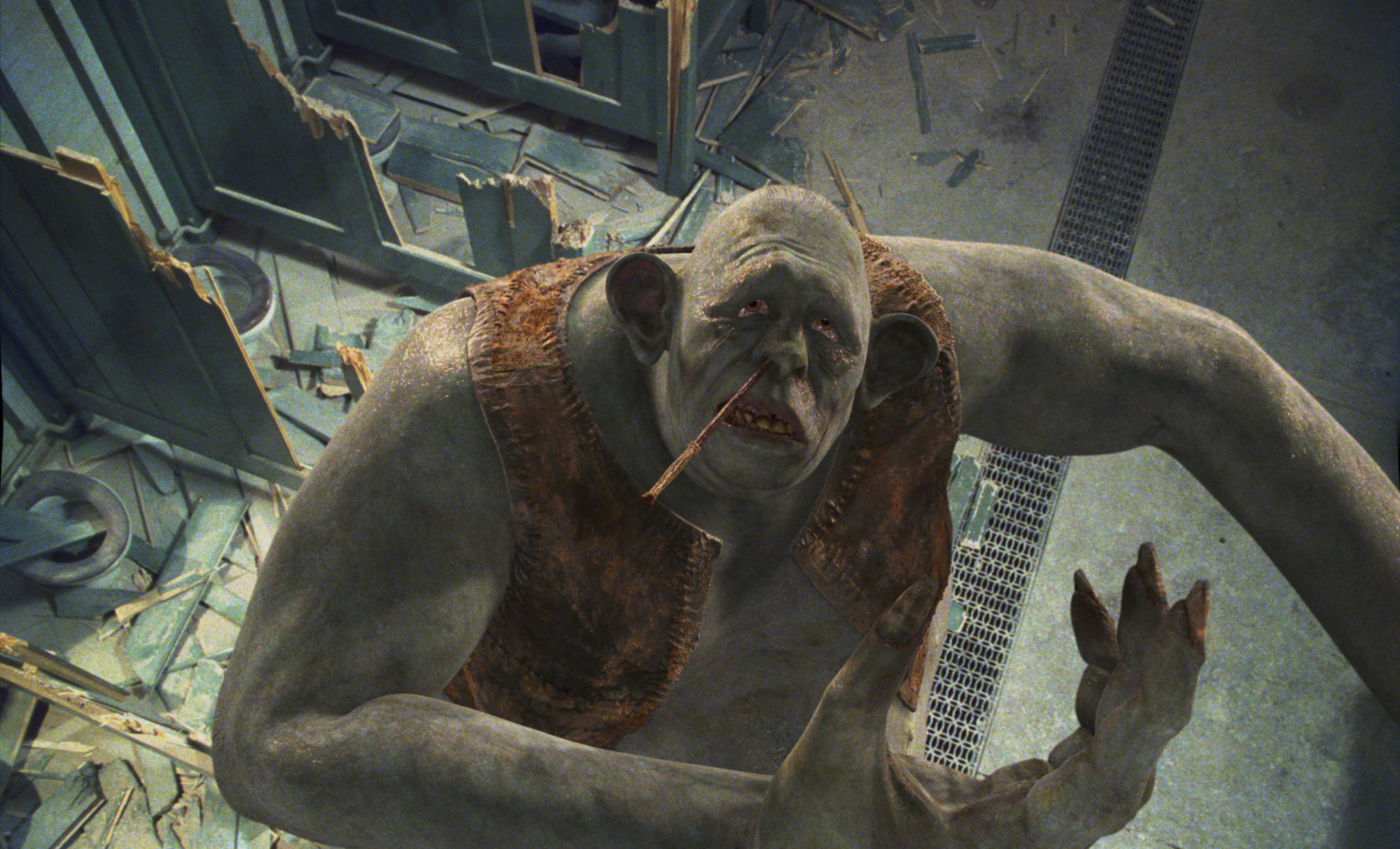
Big, gnarly, creatures called Trolls are predominant in the Potterverse. These are magical beasts with incredible strength and even more stupidity. Remember when Hermione told Ron that he had the ‘emotional range of a teaspoon’ in Order of the Phoenix? Trolls have the intelligence quotient of a teaspoon. In fact, the failing grades in wizarding exams were called ‘Troll’.
These beasts are twelve feet giants, weighing up to a tonne. Their whiskers could be wand cores, but it was inferior to the other cores such as unicorn hair, phoenix feather, and dragon heartstring. They originated in Scandinavia but were later found all across Europe.
Trolls are violent and aggressive, portraying unstable behavior and love terrible smells such as Dungbombs. Due to this and their aggressive nature, the Department for the Regulation and Control of Magical Creatures of the British Ministry of Magic categorized them under beasts instead of beings. However, they could be trained to be security, provided they had the intelligence of a tablespoon instead of a teaspoon.
Their language is pretty dumb as well. Just point and grunt. There you go. Only other trolls could understand this language, but a few wizards who were multi-linguists had learned it as well, such as Barty Crouch. In Philosopher’s Stone, the Defence Against the Dark Arts teacher, Professor Quirrell, was notably known for his gift for communicating with trolls.
There are several types of trolls:
Mountain trolls are the largest and the dumbest breed of all. They are vicious and have dark and thick skin.
Forest trolls are pale-green in color and have straw-like hair. They lived in forests and woodlands, and even in the Forbidden Forest.
River trolls had short horns and hairy purple skin. They would often lurk under bridges or in the rivers.
Troll of Nadroj is a sub-type of Troll and has disproportionate hands.
In Philosopher’s Stone, Dumbledore had hired Quirrell for his proficiency with trolls to use them for protecting the Philosopher’s Stone. However, being an antagonist, he had unleashed an enormous mountain troll in the dungeon as a means to distract everyone so that he could go after the Stone.
The troll almost attacked Hermione in the girls’ bathroom, but with the help of some ‘wingardium leviosa’ and ‘sheer dumb luck,’ Ron knocked the troll out.
There are several other types of trolls barring the dumb and smelly mountain troll in the wizarding society, and they were often used for other purposes, namely, as security guards. Training these trolls was a career as well.
In Prisoner of Azkaban, Dumbledore is seen to have hired trolls to protect the Fat Lady following Sirius Black’s attack.
After being captured by Snatchers in Deathly Hallows, Ron suspected one of them was part-Troll because of its terrible body odor.
Werewolf
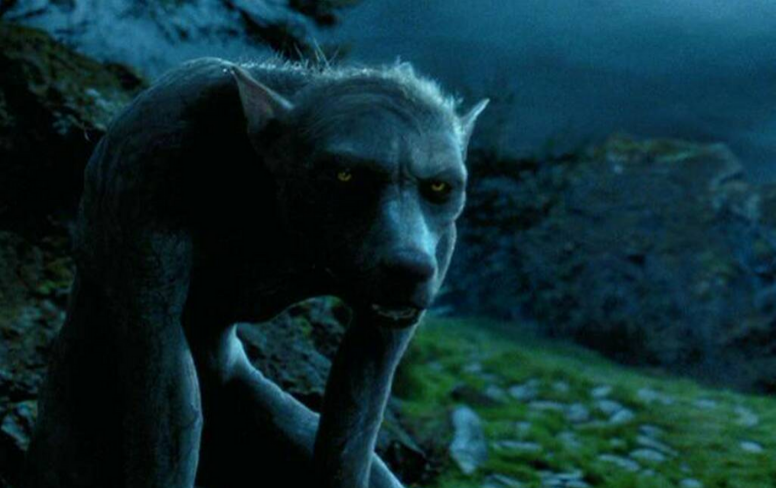
Werewolves are human beings who turn into wolves upon the rising of the full moon. Once they transform, they become uncontrollable and violent. This condition is called lycanthropy and is a prominent issue in the Potterverse, especially surrounding Remus Lupin and Fenrir Greyback.
This illness was known to spread when the saliva of a transformed werewolf came in contact with that of a person’s blood (following a bite). Remus Lupin had turned into a werewolf when he was bitten by a transformed Fenrir Greyback (the leader of the werewolves and ally of Voldemort) as a child.
The wizarding world had ostracized werewolves so they had to constantly work jobs way below their abilities to sustain a living. When Lupin worked as a professor at Hogwarts, Snape would concoct the Wolfsbane Potion for him. This is a potion that allows werewolves to keep their human mind following a transformation instead of going on a violent rampage against their will. Otherwise, they could not control their impulses and would even kill their best friend unknowingly. The worst part about this is that the werewolf will be able to recall their memories upon reverting back to their human form. But the potion was a very complicated one to make. And there was no cure for this condition. Lupin as a werewolf would isolate himself to avoid hurting humans but take his aggression out by inflicting himself with scars.
The transformation process and effects were extremely painful for the werewolf and without treatment, would take a heavy toll on the person preceding and succeeding the day of the full moon. And despite being a kind person, they could totally lose their sense of right or wrong once transformed. This was seen in Prisoner of Azkaban when a transformed Lupin attacked Harry, Hermione, Sirius, and Ron.
Werewolves could form better companionship with animals, so during Lupin’s school life, his friends (the Marauders) would turn into Animagi to give him company on the night of a full moon. This way, Lupin would not have people to harm and a lesser impulse to harm himself, something he had an affinity towards.
Fenrir Greyback was considered to be the most savage werewolf in the history of the Wizarding World and was allied to Lord Voldemort. He was dangerous even as a human, as seen since Half-Blood Prince where he teams up with Bellatrix Lestrange to burn down the Weasley household. He would often kill his victims.
He had killed Lavender Brown in the Battle of Hogwarts and bitten Bill Weasley in an untransformed state. Since Greyback wasn’t a werewolf when he had attacked Bill, he did not go on to become a werewolf. However, he did acquire some lupine traits such as a liking for rare stake.
Werewolves hated the wizarding society because they were severely oppressed for their lycanthropy. So, many of them allied with Greyback with the objective of infecting as many people as they could, intending to take over the community someday.
They also believed that life would be better for them under the rule of Lord Voldemort and gave him their support during the Second Wizard War. Remus Lupin would spy on them for the Order of the Phoenix. However, even under a new rule, they would’ve been ostracized as they were ridiculed by the Death Eaters and not allowed to have the Dark Mark.
Thestrals
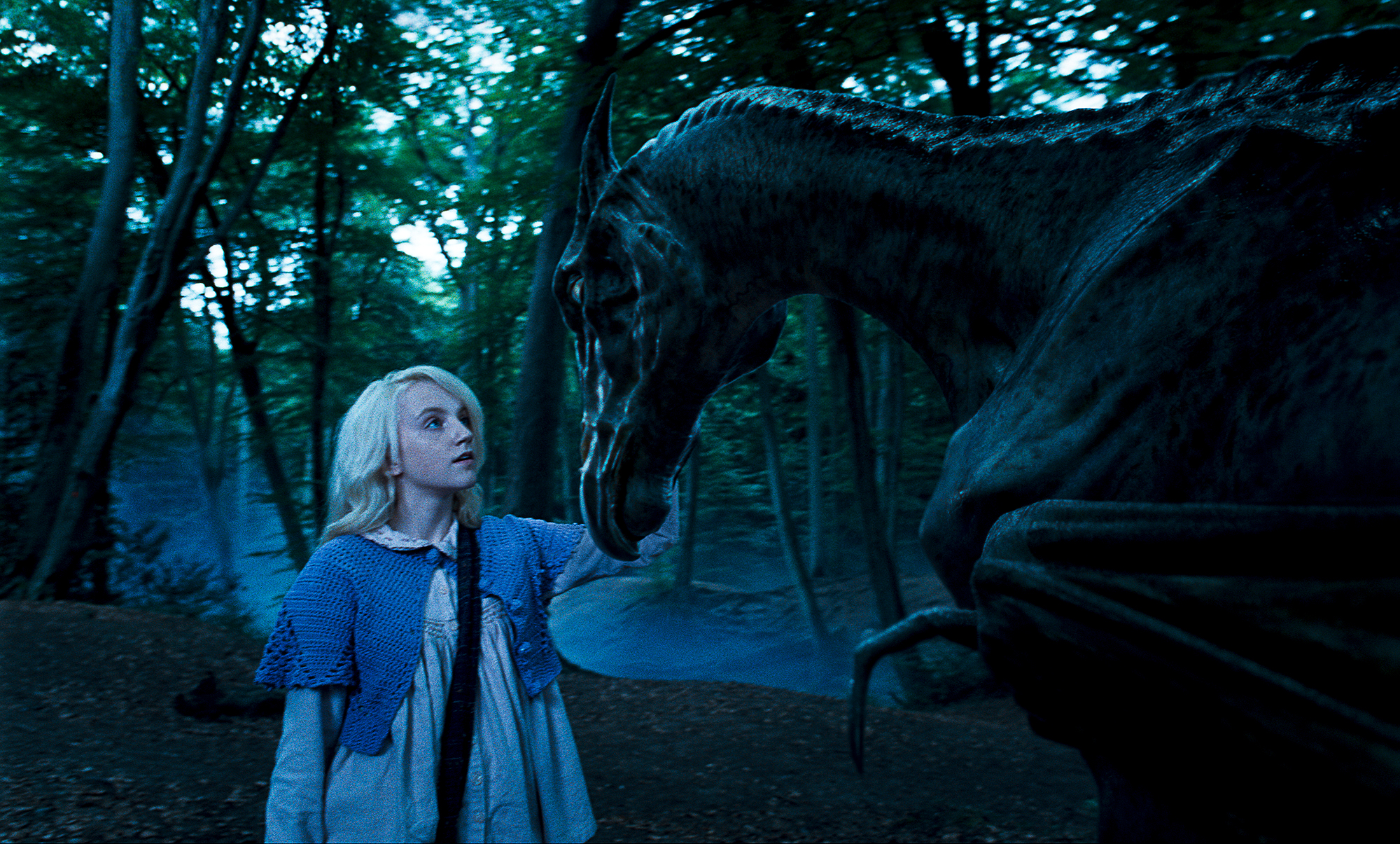
Thestrals are some of the most interesting and unique creatures not just in the Potterverse but in the realm of fantasy shows and series. These rare, winged horses were seen as a bad omen by the Wizarding World and considered dangerous. One could only see a thestral if they had seen someone die.
They had skeletal bodies with leathery batlike wings. Their features were reptilian and had a gaunt and ghostly appearance. The scent of blood lured them. Their coat was glossy and translucent with skin so thin that the creature’s bones were clearly defined. They also had long manes and sharp fangs.
It was illegal to own thestrals without the consent of the Ministry and they were categorized under XXXX which meant that only experienced wizards could handle them.
Hogwarts owned a loyal flock of these unique creatures and they were generally used to pull the carriages as the elder students were transported from Hogsmeade station to the Hogwarts Castle. Since people who have not witnessed death could not see them, they would often assume the carriages moved by themselves.
After witnessing Cedric Diggory die right in front of his eyes in Goblet of Fire, Harry was able to see the thestrals once he went back to school in Order of the Phoenix. He was initially surprised as to why horses were being used to pull the autonomous carriages and even more surprised when he found out that no one else could see them until Luna Lovegood pointed out that she could see them too.
Hagrid described them to be ‘dead clever. Trained thestrals could even understand what the rider is saying while trying to specify a location.
These creatures are loyal and can sense which one is a friend and who is the enemy. They help transport people but are aggressive towards whoever they see as a threat for either themselves or their owners.
Thestral hair was unique and powerful. It could be used as a wand core but the witch or wizard using it can only master it if they are capable of facing death. In fact, the all-powerful Elder Wand was created using thestral hair as the wand core instead of the regular unicorn hair, dragon heartstring, or a phoenix feather.
They had a series of useful abilities, the coolest one being invisibility to those who had never seen death. They also had a phenomenal sense of smell and could track distant sources of smell when coming from fresh flesh or blood. Being intelligent and used for transportation, they also had a superior sense of direction. They were fast fliers and could travel long distances.
In Order of the Phoenix, Harry, Hermione, Ron, Ginny, Luna, and Neville traveled from Hogwarts in Scotland to the Ministry of magic in London in a short amount of time to save Sirius Black. Harry, who was accustomed to riding the fastest broomstick in the market stated that he had never ridden anything faster than the thestrals.
In the beginning of Deathly Hallows, Hermione, Bill Weasley, Fleur Delacour, and Kingsley Shacklebolt rode on thestrals while being disguised as Harry as they transported the real Harry from Privet Drive to a safehouse.
In the Battle of the Hogwarts, thestrals fought on the side of Hogwarts, while cooperating with Buckbeak to attack Voldemort’s giants. Following the battle, more people could see the creatures, having witnessed so much death around themselves.
Centaurs
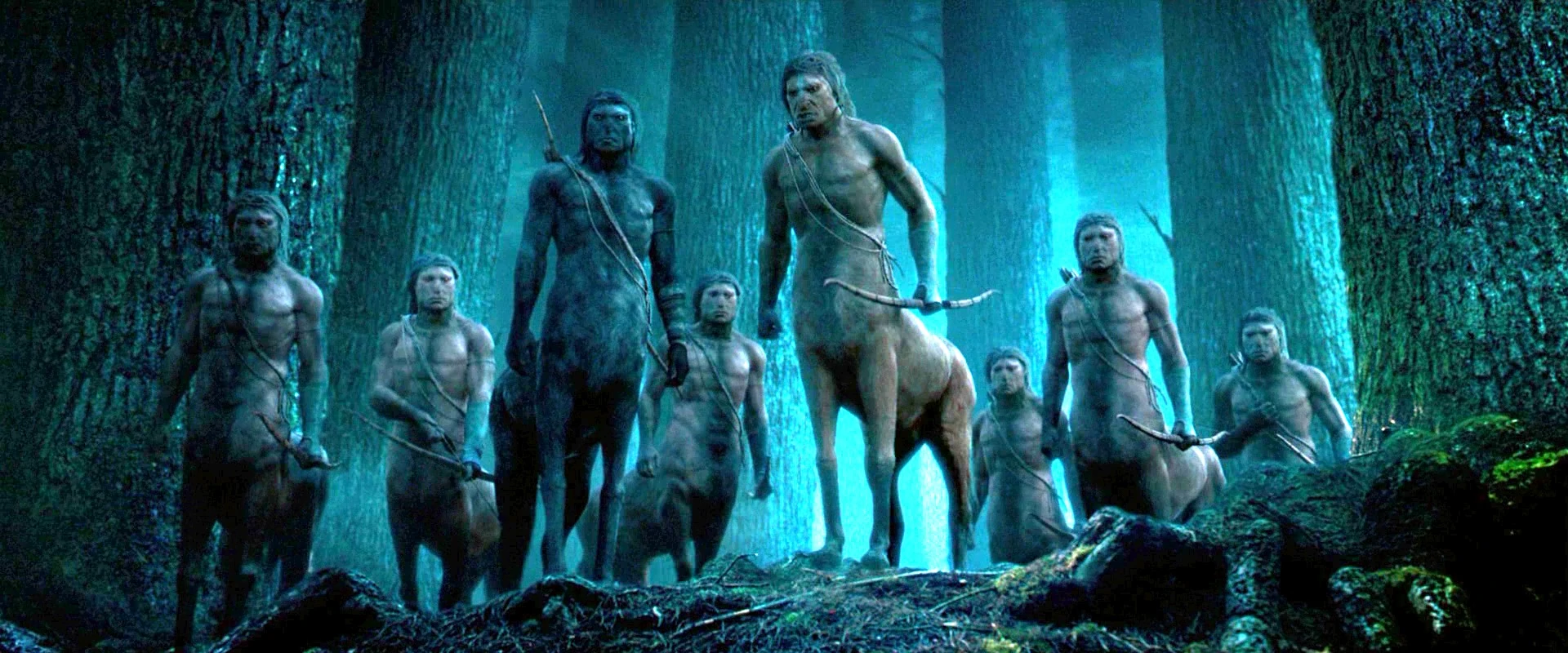
Inspired by Greek mythology, centaurs are a crucial addition to the Potterverse. This magical creature has the upper half of a human and the lower half of a horse. However, similar to Merpeople, they are not hybrids and in fact, an entirely separate species by themselves.
The Ministry of Magic classified them under beasts even though they possessed intelligence rivaling that of humans. What’s interesting is that they asked for the classification themselves as they did not want to be categorized under ‘beings’ with Hags and Vampires.
Centaurs had a rich history and a natural talent for Healing magic, Divination, and Astronomy, much to the displeasure of Professor Trelawney. They were natural-born Seers, especially Firenze who taught Divination in Hogwarts along with Trelawney in Half-Blood Prince. They also had an affinity for archery and did not use wands for magic.
They were proud as a species and did not take being insulted by Umbridge very lightly. They did not like being alluded to having been used by wizards. After Firenze had helped Harry escape from the Forbidden Forest to avoid Voldemort, the other centaurs ridiculed him for behaving like a ‘common mule’. In 1995, during the events of Goblet of Fire, Firenze had decided to work alongside humans and for this, the other centaurs attempted to murder him.
They prefer nature over technology. They use bows and arrows and read the signs in nature. Following the events where the Ministry consistently reduced the size of the land of the centaurs, the territorial creatures planned to take a stance against humans and told Hagrid that he was not welcome anymore, forfeiting their friendship, especially because Hagrid was hiding his half-brother Grawp, a giant, in the forest, during the events of Order of the Phoenix. However, they did not harm Hagrid as he was accompanied by Harry and Hermione and due to their strong sense of honor, they did not harm the young.
Towards the end of the book, when Harry and Hermione tried to use the centaurs to dispose of Umbridge, the centaurs attempted to attack them as they did not like being used by humans and also because they were nearing adulthood.
They lived in colonies in forests, notably the one at the Forbidden Forest at Hogwarts. They were not very fond of humans and avoided contact with witches, wizards, as well as Muggles. This particular colony distrusted wizardkind the most but similar to the Merpeople, they had a deep respect for Albus Dumbledore, as seen during their moment of salute during Dumbledore’s funeral towards the end Half-Blood Prince.
The herd, along with Firenze, joined the side of Hogwarts and fought the Death Eaters during the Battle of Hogwarts.
Acromantula
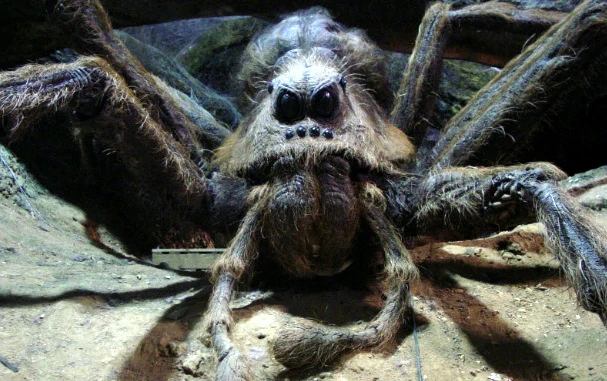
These giant sentient creatures are species of spiders and similar to the centaurs, which could be inspired by Greek Mythology, namely, Arachne. In the Potterverse, they are native to South-East Asian rainforests and are wizard-bred as a species, used to guard treasures. They also possess a taste for human flesh.
They have eight black eyes and are covered in hair with leg span going up to fifteen feet, as seen in Hagrid’s favorite Acromantula, Aragog. Their pincers produce a clicking sound and their fangs are venomous. They are also capable of human speech.
Acromantulas were social creatures and had an emotional range far exceeding that of a teaspoon (Ron Weasley, take notes). They lived in large colonies, as seen in the Chamber of Secrets when Harry and Ron visited Aragog’s lair upon the reopening of the Chamber of Secrets.
Since Aragog was friends with Hagrid, he was able to prevent his colony from eating him but he could not promise the same for Harry and Ron. Despite having formed emotional attachments, as Hagrid had raised Aragog since it was in its egg, their friendship did not extend much beyond that. This was evident in Half-Blood Prince following Aragog’s death when his colony tried to eat Hagrid.
When other spiders died, their corpses were eaten by the colony as well.
If there is one thing these large, hairy spiders feared then it was the basilisk. What Lord Voldemort was to the Wizarding World, the Basilisk was to the Acromantulas as they could not even bring themselves to speak of it and used euphemisms in place of saying ‘basilisk’. This was mainly due to the fact that Acromantulas had eight eyes and the Basilisk’s biggest weapon was killing whoever looked into its eyes.
Another Acromantula appeared in Goblet of Fire during the Third Task of the Triwizard Tournament. It was positioned close to the Triwizard Cup, causing Harry to join forces with Cedric Diggory to defeat it.4
The Acromantula colony at the Forbidden Forest also fought in the Battle of Hogwarts against the Death Eaters. It drove them out of the forest and towards the castle.
Ron Weasley suffered from severe arachnophobia, as seen during Chamber of Secrets and Prisoner of Azkaban when his boggart turned into a spider. However, it resembled a Black Widow spider instead of an Acromantula despite being huge in size, probably due to his encounter with Aragog and his colony in Chamber of Secrets
